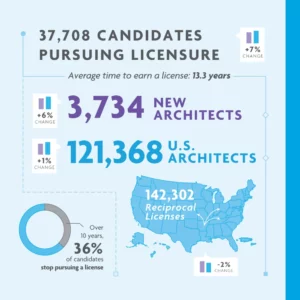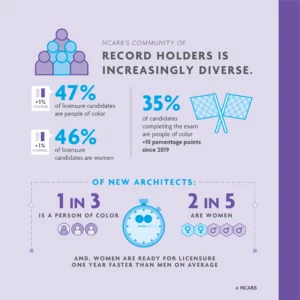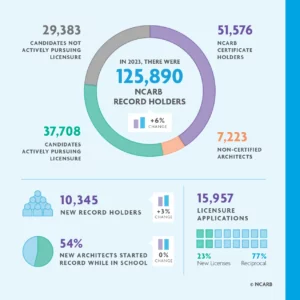NCARB BY THE NUMBERS 2024
Recently, NCARB released its annual “By the Numbers.” Today, we introduce you to NCARB by the Numbers. – https://www.ncarb.org/nbtn2024
As stated on the its website, the 2024 edition of NCARB by the Numbers, “the data reported in this publication was captured at the end of the 2023 calendar year, and much of the information gathered demonstrates growth and positive evolution: continued increases in the number of U.S.-licensed architects, higher demand for additional out-of-state licenses, increased diversity and gender parity at many career stages, and a slight decrease in the time it takes to earn an architecture license.”
More specifically, the data shared is on the following topics:
- State of Licensure
- Demographics
- Building Competency
- Examination
- Inside NCARB
- Jurisdictions
One of the first data points relates to the following:
Number or U.S. Architects Continues Upward Trend:
In 2023, there were 121,358 licensed architects across the 55 U.S. jurisdictions; this is a 1% increase following last year’s decline. Those architects also held approximately 142,000 reciprocal (out-of-state) licenses—a -2% increase compared to 2022.
The number of individuals who made progress on the path to licensure in 2023 also rose by 7%, with more than 37,000 candidates reporting experience, taking the national licensing exam, or both. As well, the number of newly licensed architects rose by 6% in 2023 to over 3,700. And at 13.3 years, the average time a candidate takes to complete these core requirements is slightly longer than the average pre-pandemic to licensure.
Now, here are some of the details from NCARB by the Numbers; for complete details, access the full report.
State of Licensure: https://www.ncarb.org/nbtn2024/state-of-licensure
Overall, licensure progress was on the rise in 2023. While the total number of U.S. architects saw a 1% increase to 121,000 following last year’s decline, the pipeline of individuals pursuing licensure saw several significant gains compared to 2022.

Building Competency: https://www.ncarb.org/nbtn2024/building-competency
The licensure process is designed to help candidates build their knowledge, skills, and abilities in areas of architecture that are essential for protecting the public’s health, safety, and welfare.
Most candidates develop these competencies through a combination of education and experience. Typically, this includes earning a degree from a program accredited by the National Architectural Accrediting Board (NAAB) and completing the Architectural Experience Program® (AXP®). However, 16% of new architects in 2023—approximately 560 practitioners—chose to earn additional experience in lieu of earning a degree from a NAAB-accredited program.
Examination: https://www.ncarb.org/nbtn2024/examination
NCARB’s Architect Registration Examination® (ARE®) is a six-part exam required to become an architect in the United States. For most candidates, taking the ARE is the final step on the path to licensure.
In 2023, the exam continued to see a slight recovery from the impact of the COVID-19 pandemic. Over 3,500 candidates completed the ARE, a 2% increase compared to the prior year. 2023 also saw a faster exam completion time and higher exam pass rates.
Demographics: https://www.ncarb.org/nbtn2024/demographics
NCARB has seen consistent growth in gender equity and racial diversity across all candidate stages over the past 5 years. As candidates progress along the licensure path, these increases become more and more apparent in the profession. In 2023, 47% of the licensure candidate population identified as a person of color, and 46% were women.
Women now make up 48% of the testing population, and typically earn their licenses faster than men—completing requirements a year sooner on average. In 2023, nearly half (43%) of candidates completing the AXP and over a third (35%) of candidates completing the ARE identified as a person of color.

Inside NCARB: https://www.ncarb.org/nbtn2024/inside-ncarb
With 55 architectural licensing boards in the United States, NCARB works to provide board support, encourage program alignment, and assist individuals seeking licensure.

Jurisdiction: https://www.ncarb.org/nbtn2024/jurisdictions
From this link, view baseline comparisons for NCARB’s 55 Member Boards, which include all 50 states, the District of Columbia, Guam, the Northern Mariana Islands, Puerto Rico, and the U.S. Virgin Islands. When you select a jurisdiction, you will find a 2023 snapshot of the jurisdiction’s experience program completion rate, examination success rate, number of licenses, and completion time for the experience program and examination.
Source: NCARB by the Numbers – https://www.ncarb.org/nbtn2024
